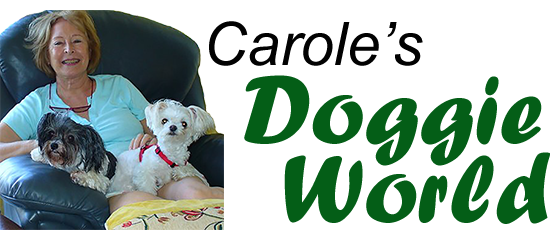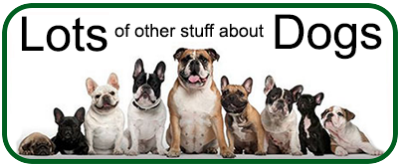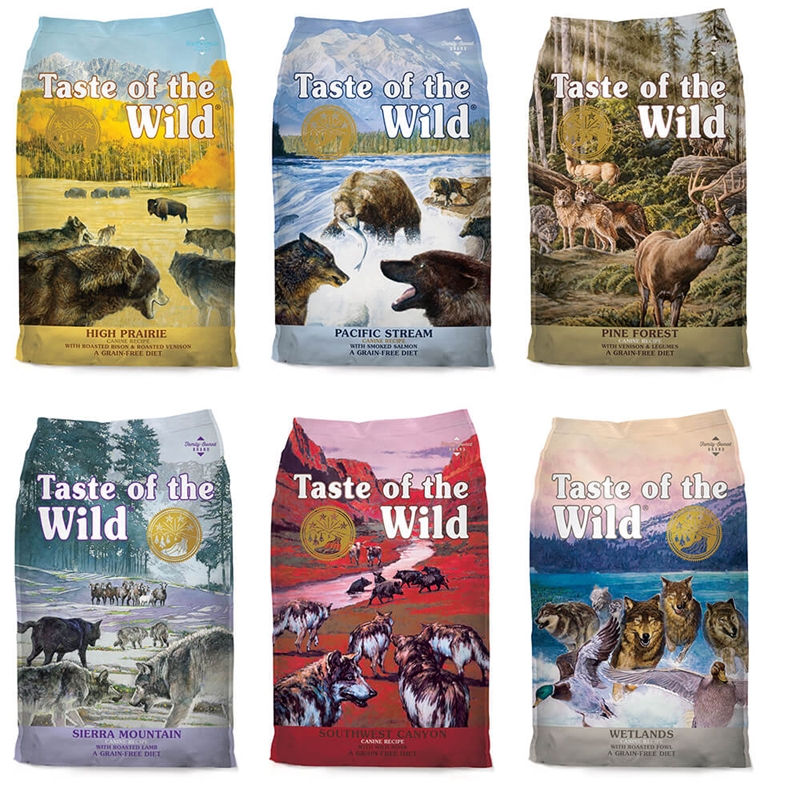Does your dog have a problem
with hair loss?
Find out about the six most common causes of hair loss in dogs
Skin diseases with hair loss in dogs | Hormone-related diseases with hair loss
Estrogen excess | Cushing's disease | Other diseases with hair loss
Allergies | Genetics | Infection or infestation | Pressure sores
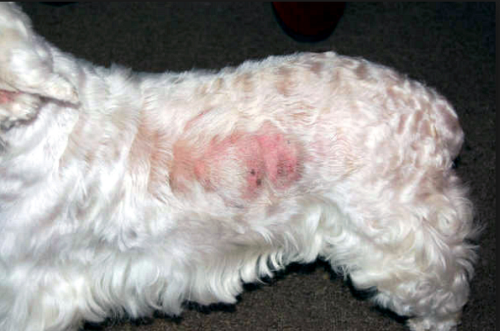
Skin diseases with hair loss in dogs
Seeing a dog lose his or her hair can be extremely disconcerting to pet parents. However, what's most important when dealing with hair loss or alopecia, as it is referred to medically, is identifying the underlying cause for your vet to be able to devise an appropriate treatment plan.
For ease of navigation I have linked and highlighted six of the most common culprits of hair loss, plus given you a brief outline of many others to look out for. In any event if your dog is itching and gnawing at itself and showing any type of hair loss, together with the stress that goes with these types of conditions you must make an appointment with your vet immediately.
Generally speaking hair loss in dogs falls into two distinct groups.
- Hair loss caused by hormonal diseases which is symmetric, e.g. the same hair loss on both sides of the body
- Hair loss caused by parasites and other causes which is asymmetric e.g. hair loss on various parts of the body, which fails to correspond to any particular shape, size, or arrangement
Hormone-related diseases with hair loss
Estrogen excess (hyperestrogenism)
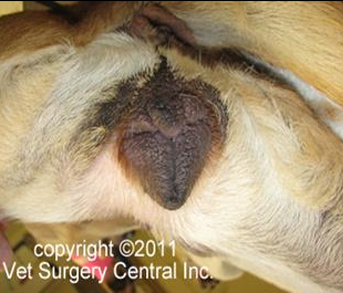
Hyperestrogenism can occur in both female and male dogs. It is characterised by bilateral symmetric hair loss in the perineum and genital areas.
Females present with enlarged vulvas and males with pendulous prepuces.
My darling Poppie went through this very unpleasant condition due to the fact that she used to lick my skin after I had applied Hormone Replacement Therapy cream.
estrogen deficiency (hypoestrogenism)
Hypoestrogenism usually occurs in older spayed females. Scanty hair growth and thinning coat, initially around the vulva and later over the entire body. The skin becomes smooth and soft almost like a baby's skin.
Cushing's disease (hyperadrenocorticism)
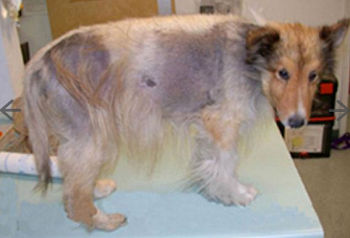
Cushing's disease also known as hyperadrenocorticism, it's a condition that is occurs in middle-aged to senior dogs and presents with symmetric hair loss over the trunk and body.
It can also be caused by the prolonged use of, or over exposure to excessive levels of the hormone cortisol.
Symptoms of Cushing’s disease include:
- Hair loss
- Darkening of the skin
- The development of a pot-bellied abdomen
Alopecia
Alopecia is the name many vet dermatologists have given to the hair cycle abnormality that affects primarily Nordic breeds and Toy or Miniature breeds.
- Other names for this condition in the veterinary literature included:
- Adult onset growth hormone deficiency
- Growth hormone-responsive alopecia
- Castration-responsive alopecia
- Adrenal hyperplasia-like syndrome

Breeders often refer to Alopecia as either Coat funk of Malamutes or Black skin disease of Pomeranians. The term I prefer is Hair cycle arrest.
Alopecia hair loss occurs mainly in male dogs and begins around puberty. The conditions is more prevalent in certain breeds, including:
- Airedales
- Boxers
- ChowChows
- Dobermans, this breed is known for a genetic type of colour mutant alopecia called Blue syndrome (Acanthosis nigrans). Hair loss usually starts in the armpit folds and on the ears, progressing all over the body giving a moth-eaten look, together with papules and pustules
- Pomeranians
- Keeshonds
- Pomeranians
- Malamutes
Keep updated with all that's
right for your best friend!
click on this link
to subscribe to our free mailing list.
Other diseases with hair loss

Allergies
Allergies are a frequent cause of hair loss in dogs.
This may due to environmental triggers such as pollen, molds and dust mites, or due to parasitic triggers like fleas or mites. In the case of flea allergies, it is recommended that dogs take flea preventatives as a way to minimize threats of a full-blown flea infestation.
Food allergies are another possible cause of hair loss. Typical symptoms of an adverse allergic reaction include itchiness resulting in excess scratching, biting, and of course, hair loss.
Genetics
There are some breeds of dog that are more genetically prone to baldness than others.
First there are the hairless dogs that have been bred for the attribute, such as the:
- Chinese Crested
- Mexican Hairless (Xolo)
- American Hairless Terrier

Then there are other dog breeds, that are genetically predisposed to various form of alopecia,such as:
- Doberman Pinschers
- Dachshunds
- Chihuahuas
- Italian Greyhounds
- Whippets
Demodex mange mites
Demodex mange mites are the most common type of mites in dogs, and they are responsible for causing a skin disease known as demodicosis or demodectic mange, also commonly referred to as red manage.
- Hair loss, especially around the face, involving th eyelids, lips and corners of the mouth.
- Occasionally demodex mange mites can be found on the legs or trunk, giving a moth-eaten look.
If not treated severe skin problems will develop and very often are complicated by the presence of pyoderma - The condition primarily affects young adults with immune deficiencies.
- The development of secondary infections.
Infection or infestation
An infestation with parasites such as fleas, ticks, mites (mange) and and fungal infections for example ringworms are all sources of canine alopecia.

Along with hair loss around the ears, eyes, abdomen, and chest, signs your dog may have mites or and ticks include:
- Inflammation
- Itching
- Redness of the skin
- Bacterial infections
Although the name suggests otherwise, ringworm is not caused by a worm at all-but a fungus. It is high contagious to other family pets and human members of the dog's family. Symptoms of ringworm include:
- Circular or irregular hair loss
- Inflammation
- Red circular infected crusty lesions
It's also possible for a dog to carry the ringworm fungus and not show any symptoms whatsoever.
Nasal solar dermatitis (Collie nose)
Collie nose is characterised by loss of hair at the junction of the dog's nose and muzzle. The condition can lead to severe ulceration, and affects mainly dogs with lightly pigmented noses.
Pressure sores

Pressure sores, also called bedsores or decubital ulcers are more common in older dogs, and especially large or giant breeds. The sores are localised injuries where a dog’s elbows or other bony pressure points, such as hips and hocks have come into contact with hard surfaces on a regular basis.
This constant pressure and friction causes the skin to form callases which present as thickened pads of wrinkles skin, which involve:
- Loss of hair
- Cracked, painful and bleeding pressure sores
Sebaceous adenitis
Sebaceous adenitis is seen mainly in Standard Poodles, but does occur in other breeds, including Akitas. The condition appears with symmetrical loss of hair over the dog's face, head, neck, and back.
Vitiligo
Some hair loss occurs with vitiligo, however the most noticeable symptom of this condition is the loss of pigment that causes hair to change color. It is seen mostly on the face and head of the dog and affects mainly:
- Rottweilers
- Belgian Tervuren
Zinc-responsive dermatosis:
Crusty, scaly skin with hair loss over the face, nose, elbows, and hocks. Cracked feet. Caused by zinc deficiency. Arctic or Northern breeds are most susceptible.
Reference: www.petmd.com
Images: www.pinstopin.com
Images: www.vet.utk.edu
Image: www.petmd.com
Image: www.bekindtopets.com
Image: www.petsbestrx.com
Images: www.romprescue.com
This article and information forms part of the Carole's Doggie World Holistic Library and is presented for informational purposes only.The information is not intended to be a substitute for visits to your local vet. Instead, the content offers the reader information researched and written by Carole Curtis for www.carolesdoggieworld.com
